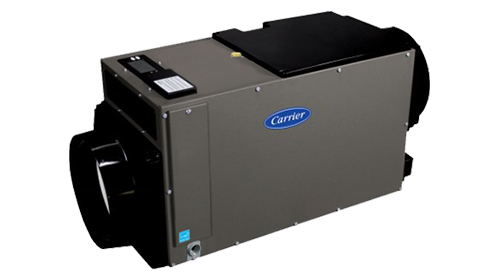Dehumidifiers Kitchener – Waterloo – Cambridge
Dehumidifiers: The Key to Comfortable and Healthy Indoor Air
Humidity can be both a blessing and a curse. While it helps us feel more comfortable in dry climates, excessive humidity can lead to a range of problems in your home or business. From the growth of mold and mildew to the discomfort caused by sticky, damp air, high humidity can seriously affect both your health and your property. Fortunately, dehumidifiers offer an effective solution to this problem by reducing the level of moisture in the air, promoting better indoor air quality and a more comfortable environment.
At Infiniti HVAC, we specialize in providing high-quality dehumidifiers that help create a healthier and more pleasant atmosphere. Whether you need to control humidity in a small room or across your entire home or business, we have the perfect dehumidifier for your needs.
What is a Dehumidifier?
A dehumidifier is an appliance designed to remove excess moisture from the air in a room or building. These devices work by pulling in the humid air, cooling it down to remove water vapor, and then releasing dry, cool air back into the space. The collected moisture is typically stored in a reservoir, which needs to be emptied periodically, or it can be drained directly through a hose for continuous operation.
Dehumidifiers come in various sizes and capacities, ranging from portable units for individual rooms to whole-house systems integrated with your HVAC system. They are widely used to maintain an optimal humidity level of around 30-50% to improve comfort, prevent damage, and protect your health.
How Do Dehumidifiers Work?
Dehumidifiers work by using a process known as condensation to remove moisture from the air. Here’s a step-by-step breakdown of how they work:
- Air Intake: The dehumidifier draws in moist air through its intake vent using a fan.
- Cooling and Condensation: The humid air is passed over a set of cooling coils, which cools the air down to a temperature below its dew point. This causes the water vapor in the air to condense into liquid form.
- Water Collection: The condensed water is collected in a reservoir or drainage system, while the now dry air is reheated and expelled back into the room.
- Continuous Operation: This process repeats, with the dehumidifier constantly removing moisture from the air, helping maintain the ideal humidity levels in your home or business.

Contact Us to Schedule a Consultation
Benefits of Using a Dehumidifier
- Prevents Mold and Mildew Growth: One of the primary reasons to use a dehumidifier is to prevent mold and mildew. High humidity creates an ideal environment for mold and mildew to thrive, which can lead to unpleasant odors, damage to furniture and walls, and health risks. By reducing moisture levels, dehumidifiers help stop the growth of these harmful fungi.
- Improves Indoor Air Quality: Dehumidifiers improve air quality by reducing the presence of mold spores, dust mites, and other allergens that thrive in humid environments. This can be especially beneficial for individuals with allergies, asthma, or respiratory issues, as it reduces airborne irritants and creates a cleaner, healthier living space.
- Prevents Property Damage: Excess moisture can damage your home’s structural components, such as wood, drywall, and insulation. High humidity can cause wood to warp, drywall to soften, and paint to peel. A dehumidifier helps protect your property by keeping humidity at optimal levels, thereby reducing the risk of damage and expensive repairs.
- Increases Comfort: High humidity can make a room feel warmer and stickier than it actually is, leading to discomfort. By removing excess moisture, dehumidifiers help maintain a comfortable and pleasant indoor temperature. You’ll feel cooler and more relaxed without the added heaviness of humid air.
- Faster Drying of Laundry and Other Items: Dehumidifiers are ideal for drying clothes, towels, and other fabric items in humid climates or in rooms that tend to be damp, such as basements. They speed up the drying process and help prevent the growth of mold and mildew on fabrics.
- Reduces Musty Odors: Damp, humid environments often produce a musty odor, which can linger on furniture, carpets, and fabrics. Dehumidifiers remove the moisture that causes this odor, leaving your home smelling fresh and clean.
- Prevents Rust and Corrosion: Excess moisture in the air can lead to rust and corrosion on metal surfaces, machinery, and appliances. By keeping the humidity levels in check, dehumidifiers help protect valuable items from damage caused by moisture-related issues.
Types of Dehumidifiers
- Portable Dehumidifiers: These are smaller, stand-alone units designed for use in individual rooms or spaces. They are ideal for localized moisture control and can be easily moved from room to room.
- Whole-House Dehumidifiers: These units are integrated with your HVAC system to control humidity levels throughout the entire house. Whole-house dehumidifiers are perfect for large homes or areas with persistent humidity issues.
- Desiccant Dehumidifiers: Unlike refrigerant-based dehumidifiers, desiccant dehumidifiers use a moisture-absorbing material to extract moisture from the air. They are ideal for colder environments or spaces where refrigerant models may struggle.
Choosing the Right Dehumidifier
When choosing a dehumidifier, consider the following factors:

Room Size
Ensure the dehumidifier you choose is capable of handling the square footage of the room or area you want to dehumidify.

Energy Efficiency
Look for Energy Star-rated dehumidifiers, which consume less power and save you money on electricity bills.

Humidity Level
Some dehumidifiers are better suited for extremely humid conditions, while others are more effective in moderate humidity environments.

Noise Level
Consider the noise output of the unit, especially if you plan to use it in a bedroom or living area.

Drainage Options
Decide whether you want to manually empty the reservoir or prefer a model that offers continuous drainage.
Frequently Asked Questions (FAQ)
The ideal indoor humidity level is between 30-50%. Keeping humidity within this range helps prevent mold growth, improves air quality, and maintains comfort.
If you notice excess moisture, mold growth, musty odors, or dampness in certain areas of your home (especially basements or bathrooms), a dehumidifier can help alleviate these issues. You can also use a hygrometer to measure the humidity levels in your home.
The energy usage of a dehumidifier depends on its size and the amount of moisture it needs to remove. Energy-efficient models, such as those with the Energy Star label, use less electricity, helping to reduce your energy costs.
The frequency of emptying the water reservoir depends on the size of the dehumidifier, the humidity level in the room, and how long it runs. On average, a dehumidifier’s reservoir may need to be emptied every 1-3 days. Some models offer continuous drainage, so you don't need to empty the tank manually.
Yes, by reducing humidity, dehumidifiers help control allergens like dust mites, mold spores, and pet dander, which can trigger allergic reactions and asthma symptoms.
With proper maintenance, a dehumidifier can last 5-10 years. Be sure to clean the filters regularly, replace them as needed, and check for any signs of malfunction to ensure long-term operation.
For portable dehumidifiers, no professional installation is needed. However, for whole-house dehumidifiers that integrate with your HVAC system, it’s recommended to have a professional install the unit for optimal performance.
Yes, dehumidifiers can be used year-round. In winter, when the air tends to be drier, a dehumidifier can help prevent excessive moisture build-up and keep the indoor air at a comfortable level.
Regular maintenance includes cleaning the air filters, emptying the water tank, and ensuring proper drainage. It’s also essential to check for any blockages or malfunctions to ensure optimal performance

